STORY LIBRARY
How many times have you been asked, “What is art therapy?” There are many ways to describe art therapy and often a story is a powerful way to share our work. We know these amazing stories because we experience them every day and have the honor of witnessing the impact of art therapy in people’s lives. Now it’s time to share those stories with the world.
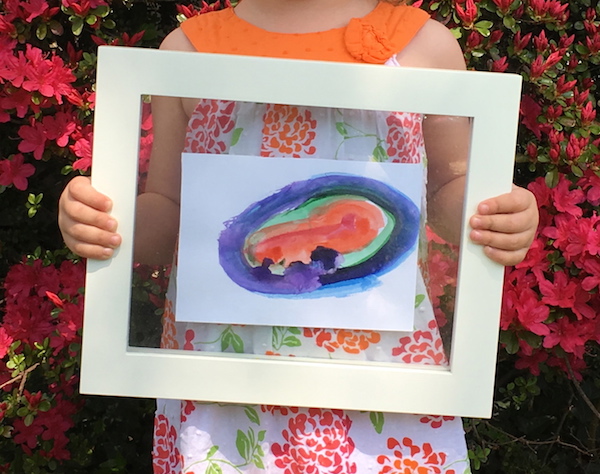
“Beth’s Gift to Her Family”
By Laurie Dombroff, MA, BFA, LGPAT
I work with adults, many who have dementia, at the Easter Seals of Greater Washington, Adult Day Center in Silver Spring, Maryland. Several years ago, I met Beth, who was in the late stages of dementia. The disease had progressed and when I met her she was no longer verbal. So together, Beth and I began to explore different art materials.
READ MORE
Most did not seem to engage her. She had no language and little to no affect. I relied on any subtle changes in her face or body movement to find an art material she would be receptive to. One day, I offered her a Buddha board and placed the wet brush in her hand. I guided her hand to the board and she began to make marks on her own. I was hopeful that I had found her medium. The next week, I tried watercolor. We put the brush in her hand and she began to move the brush around. We changed the color and she continued surrounding the shape until it was enclosed. The staff and I were unsure of the meaning of the image, but we were delighted that in that moment she was able to make such a deliberate image.
Beth died a short time later. Her family came to the center to thank the staff shortly thereafter. On that visit the staff showed them the painting and they understood its meaning immediately. Beth had been a labor and delivery nurse, and her daughter was expecting a baby in the coming months. Beth had found a way to tell them she knew. Hannah was born on Beth’s birthday.
This story is a constant reminder to me about how important this work is. I hold on to the idea that even when it seems as if a participant can no longer express themselves, through guided art making it is still be possible.
“Fading Colors”
By Sheryl Stern, ATR-BC, LCAT, LMFT
He chose orange from the paint tray! Smiling, his brush heavy with color sweeps across the page. What follows is blue. At times the colors intersect, and he is pleased. I know this much because he’s laughing. What I don’t know, is what brings about his joy. He identifies another color. And with equal enthusiasm, he covers the paper. He sits back and observes his art. “Are you done”, I ask. A smile is followed by a simple “yes”. The art is set aside and saved.
READ MORE
The paint tin, paper and brushes sit in front of him. He doesn’t know what to do. I ask if he’d like to paint? I ask about color choices, which have been narrowed to just a few? Using hand over hand we create little by way of color, movement or enjoyment.
The art is set aside and saved.
No paint, no smiles, few words are exchanged upon my next visit. I set up his passed brightly colored art pieces, next to the fading works which followed. All were set aside and saved. He appears as if he recalls the joy they brought. However…I don’t know. What I’m seeing is the blank stare of Alzheimer’s Disease. And this is my brother.
“From Imprisonment to Inspiration”
By Erin Partridge, PhD, ATR-BC
I have the honor of working with older adults in art therapy and as core-searchers. The following quote comes from a Japanese-American survivor of the internment camps: “Years ago, your words of amazing wisdom: ‘maybe you’d like to make a collage?’ Yes, I did make it, finally…In working on this collage I began to see…I’ve lost much of that anger and resentment. I’ve been helped by collage, art, and you. And now, I have some good feelings about this, my collage. I like some of it. I feel good.”
READ MORE
She sees art as a way to tell her story beyond her words and has created an exhibit of her drawings of the prison camps along with a framed news article about her experiences. Art therapy creates a space for her to process her past experiences and empowers her to continue to be an activist and an advocate; age does not exclude her from the conversation. The work of an art therapist opens doors to interactions with so many parts of the human experience. I feel so lucky to work with these dynamic people in the last decades of their lives; they inspire me and push me to be better, to think outside my own experiences, and to see the world from different perspectives.

“My Journey”
By Julie Houck, ATR-BC
Sharing my art therapy story.
When in high school, I enjoyed and excelled in psychology classes. When subsequently looking for professions that appealed to me, I was delighted to find the art therapy profession that married both my interests of art and psychology. As an undergraduate, my areas of study were the arts, with a concentration in painting, dance, and art therapy.
READ MORE
While raising three children, teaching and producing art was a flexible way to stay involved in my profession while affording me family time. When I was 40 years old, I decided for the first time to enter a calling for artwork that would represent Yom HaShoa, the Holocaust Remembrance Day.
My father, who had been a Holocaust survivor, was no longer living. As the child of a Holocaust survivor, I felt moved to rise to the challenge and call for making a meaningful piece of art. I had long held onto my father’s traumatic story, which he shared with me when I was 12 years old. The story he told me was how my grandmother, for whom I am named, died during the removal of Jews from Budapest, Hungary in the early 1940’s. He was 13 at the time he witnessed his mother shot by the Germans as he and his mother were forced to walk from Budapest towards a cattle car headed for Germany. My father told me that my grandmother was no longer able to walk on the march when she was shot in the woods in front of my father.
During my art therapy education I was very influenced by Lucia Capacchione’s books on emotional healing. I decided to take the plunge and face my fear of exposing a very raw, vulnerable and emotional experience. The 18 x 24 painting I created I had long imagined in my mind’s eye was done in pencil allowing me some emotional control. Although my art piece was not selected for the Yom HaShoa competition, I felt that I had won. Painstakingly drawing this image and another in pastel, adding color and the gore of blood, while working out my feelings in a journal helped me to free myself of my father’s traumatic experience, and that of my grandmother and myself, which I had carried with me silently for 28 years. The paper became the sacred space to express my family story.
I had learned the power of art therapy from my coursework. Yet, through my own personal experience I intrinsically had a new level of understanding and catharsis. It was a relief for me to now have the image outside of myself, to document a story I no longer needed to carry in my body and in my mind. By using pencil I had the control that I needed to reveal the image of how I heard my father’s story. I was able to clear away a large, heavy -hearted story in my mind’s eye. After the two images, I felt as if a large weight was released. I was free. Letting my inner experience be expressed outside of myself felt so liberating. I was able to breathe a sigh of relief and my body also felt so much lighter. It was my strong and sustained interest in psychology, art, and the power of my own experience that inspired me to go back to school and pursue a Master’s degree in art therapy.
After receiving my graduate degree in Expressive Arts Therapy, at Prescott College in Prescott, AZ, I have worked with many children, as well as children living in adult bodies, who were unable to express preverbal experiences or traumatic experiences for which they had no words or a true understanding of their past emotional experiences which were interfering with becoming their true essence. I have learned that Art Therapy not only helps to make sense of one’s experiences, but offers catharsis by bringing long held unconscious material to the conscious level.
As a result of my training, art therapy mentors, and my own personal experiences, I have been very fortunate that others have entrusted me not only with their stories, but also with their personal journey towards healing. I understand the fear and courage it takes to trust in the process, and the overwhelming feelings that follow by bringing vulnerability to surface.

“Que Te Vaya Bien Mi Nieto”
By Melissa Clarke, ATR, LMHC
A few years ago, in 2014, the small, sanctuary city of Chelsea, MA welcomed the wave of unaccompanied minors arriving at our nation’s border. This warm embrace was very much needed, as the children who arrived in Massachusetts were in search of reunifying with their families as well as a life in which they could seek safety away from the persecutory, gang violence that has taken over their communities.
READ MORE
Not only are these these children and families born into a life woven with layers of generational trauma, but they are fleeing their beloved country and culture to make the treacherous journey from either Guatemala, Honduras, or El Salvador with the dream of reaching the U.S Border. This journey is embedded with atrocity and horrific trauma, and seems to persist when these children reach the large, over-crowded, freezing detention centers, otherwise known as ” un carcel”- a jail or “la hieleras”- the icebox.
In order to tell this story and begin to heal from this trauma, a young boy who was 11 at the time of crossing the border, and who is now 14 years old shared with me, his art therapist through this collaborative art making piece. Together, the two us crocheted and sewed small granny squares from tethers of fabric ripped and tied together from an old purse taken on many journeys this art therapist took, and used the bag until it couldn’t hold anymore.During the art
making process, this boy began to tell this therapist about how cold the detention center was and how saw a small boy who was scared and trembling. The boy described, that in this moment, he felt that while his situation was frightening, this other boy needed to be sheltered. This client shared how he gave the boy his sweater, but in the moment wish he could cover him in a blanket. As this client spoke, he reminded this therapist about the lack of human dignity in the detention center and being stripped of all of what little things he had left, such as documents, photos, and phone numbers. As a response he created the center of the blanket with a secret zipper pouch to hold his belongings. This final piece shares his story of being sent off to the U.S by his Abuela whom he left behind, yet is covered memories of the bright fabrics to keep him safe and warm.
“Guns and Roses”
By Laura Martin, ATR-BC, LPCC
There are times when art therapy has a clear advantage over traditional talk therapy in moving the client from one emotional space to another. Early in the school year, an eleven-year-old male was brought into my school-based counseling office because he had threatened to shoot a peer. In the process of assessing for a plan and access to a weapon, it became clear Evan* was very angry, but was in no true danger of committing homicide.
READ MORE
I had him draw a picture of his anger, and he drew what you might expect: a stick figure boy pointing a gun at a stick figure girl. As we talked about the consequences of his desired actions, and then brainstormed alternative solutions, Evan calmed down and began to see reason. He turned the paper over and drew a car. Then he asked for another sheet of paper to redraw the car because he wanted to keep the car drawing, but not what was on the other side. I encouraged him to go back to his original drawing and change it to reflect his calmer, more positive state. He drew over some elements, changing the gun to a bouquet of flowers, and spurts of blood to hearts. He looked up and abashedly admitted, “I have anger issues.” In less than an hour, this client had moved from homicidal ideation to literally changing his view of the situation. All through the power of art therapy.
*name has been changed
“Imagining Before Actualizing”
By Scheherazade St. Martin, Ph.D., ATR
Art therapy has an amazing breadth of application for all ages and cultures. I discovered this personally first as a student in the Art Therapy Program at Sonoma State University. I went on to bring art therapy interns from SSU into an elementary classroom setting in the Novato Unified School District, beginning with one pilot program that expanded into eight elementary schools, three middle schools, and two high schools.
READ MORE
Later, I brought art therapy to the University of Guadalajara Department of Health Sciences, working first with children of faculty and eventually establishing an art therapy training program there. It became so popular that the Department of Health and Human Services in the State of Jalisco, through the Secretary of Education, developed and expanded a program through the public schools that eventually reached over six thousand children. This program, in turn, was recognized by the Congress of Mexico through the passage of a law to bring art therapy rehabilitation services to child victims of violence and difficult circumstances in the border states of Mexico.
“I am an Art Therapist”
By Robyn Spodek Schindler, ATR-BC, NCC, LCAT, LPC
As I continued down my path of What will I be when I grow up? I became more and more in love with what I was studying, who I was talking to and what I was doing. Yes, even my mother began to see that I might actually be able to make a living one day. I think this is why, when people scoff and joke about art therapy, I am unfazed.
READ MORE
I mean, I get it—it sounds a little out there. But when my father said to me, “As long as you are happy,” when I told him I was changing paths it all changed for me. And yes, I am happy. Helping children and teens makes me happy. You may not be able to understand why I do what I do but that’s not important. This is what I try to instill in every child I see: “Do what you love. Create your own happiness.” That’s my happiness.
I achieved my dream. No, I’m not a doctor, but I am helping sick children. Does it matter more to you if I say I am helping a 10-year-old boy cope with the fact that he is dying from disease? Or that I took a once suicidal teenage girl who could not say one nice thing about herself and helped her build self-esteem so that she can speak anywhere in front of anyone? Or perhaps I should mention the 5-year-old that wouldn’t speak due to years of abuse and how he is now playing and enjoying being a kid? But that’s not what I say. When someone says, Art therapy? What is that? Does that really work? I answer with total confidence, Well, it works for me and it works for the families I’ve helped.
Am I a psychotherapist? Yes indeed. But I replaced the “couch” with a sand tray and the coffee table with an easel. You may not understand what it is that I do or why I do it, but hey, I have no idea why you are an accountant. To each his or her own, right? We all have choices and I choose to be me. I hope your children choose to be themselves.
From a blog post of mine @Paintthestarsarttherapy on Tumblr.
“Legacy Work in Blown Glass”
By Tina Boscarino, ATR-BC
Sometimes being an art therapist means going beyond making art with your client. When it comes to creative work, thinking outside the box is always a good thing. This past summer I visited the Museum of Glass in Tacoma, Washington, and saw wonderful examples of their Kids Design Glass program – a glass sculpture blown from one of the hundreds of children’s drawings submitted monthly. I knew instinctively that I’d be using this program in my work at some point.
READ MORE
Returning from that trip, I soon began a new job working with children in hospice and palliative care. One of my patients was a nine year old boy with a brain tumor who soon lost use of his hands. Since a young age this talented boy had wanted to be a famous artist, and had created a large body of work that his parents shared with his fans through Facebook. With his parents’ permission, I contacted the Museum of Glass administrative office to see if this child’s artwork could be considered for the Kids Design Glass program, and gave them the Facebook page. Within hours I got a call back from the artistic director. The usual application process was waived, and the piece would be blown and broadcast live on their website in just ten days. I acted as liaison between the family and the Museum. The boy’s parents were allowed to pick the drawing, and they chose their child’s “signature piece”, a simple alien figure their child had drawn next to his name on school papers, to be made in his favorite color. Two copies of the piece were made – one for the Museum, one for the family. Although the boy could no longer see with his eyes when the sculpture arrived, he was able to see it through touch and hear and understand what was happening during the entire process.
The boy’s mother shared the event and photos of the finished piece on her son’s Facebook art page, and eventually she was able to give me a statement for the the Museum to post on display and on social media. The child’s wish of becoming a famous artist was advanced, and his family now has a museum quality glass sculpture designed by their son that they will always cherish.
“Calmness through the Chaos”
By Courtney Martin, ATR-BC
I am an Art Therapist here at the Tracy’s Kids program at Methodist Children’s Hospital in San Antonio. When thinking about how art therapy is integrated into our medical community, I immediately thought the best way to convey this would be to hear from our patients themselves. One patient in particular spent months in the hospital and oncology clinic, where she utilized both individual and group art therapy.
READ MORE
Below are the words she wrote:
“I wanted to tell you how much your program has helped me. Tracy’s Kids has helped me learn to express myself through art. While I was in the hospital, the art program helped me cope with many things that were going on. I would feel a calmness when things got hectic…The program has helped many patients come together through art. The Art Therapist not only helps with art, but also helps get us through our medical situations”
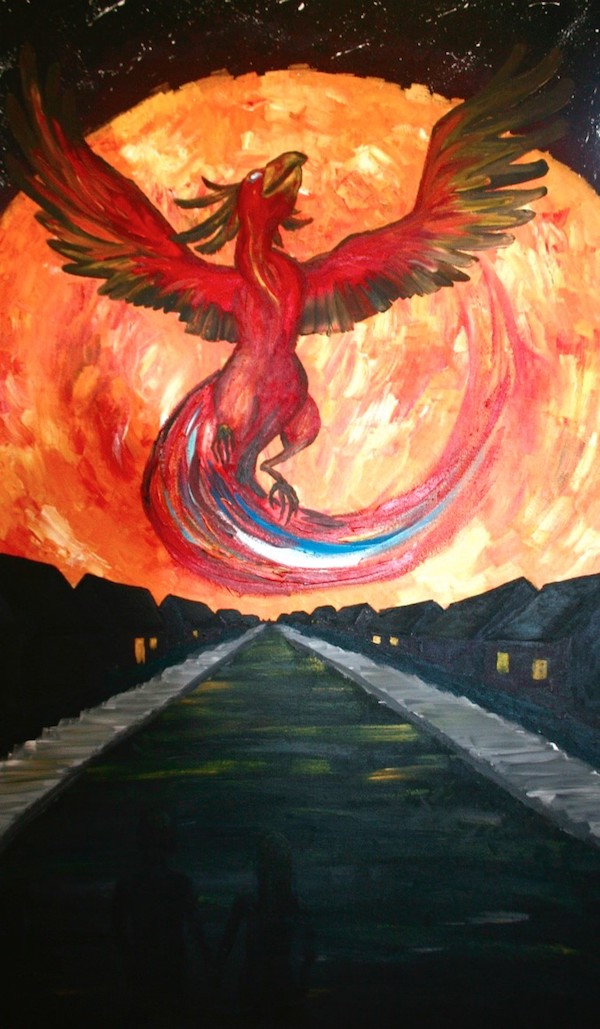
“Phoenix Rising”
By Natalie Foster, LMAFT, pursuing ATR
In 2008, my family member revealed that he had secretly been caught in a fullblown heroin addiction for the previous six years. Before, I thought I knew him. I thought he just acted a certain way, dressed a certain way, and had certain less than- positive attributes about him. I thought he was flaky and non-committal. I thought his personality was just a little “off”. We did not know that he was battling such a darkness that he would later describe as “handcuffs”– keeping his own hands bound behind his back, powerless to stop the cycle of his addiction.
READ MORE
My family member was the first to bring the field of art therapy, and my eventual life purpose, to my attention. Having undergone a heavily art-focused treatment, he credits it to be the single most powerful aspect of his own recovery. This was most surprising to me as he was never the “artistic” one. In the middle of his treatment, my entire family had a session using collage and markers. It was one of the few times I have witnessed such honesty and emotion between all of us. My family was unearthing years of buried resentments, secrets, and unsaid words in a single hour. For my afflicted family member, and for the rest of us, it was truly a healing experience. Later that month, I sat for four hours and furiously painted him as a Phoenix, rising from the ashes. And rise he did– he went through heroin rehab that one single time, nearly nine years ago, and has never looked back since. He now has a loving family of his own, his own business, and is a completely different person than the one I knew before I discovered the brilliant field of art psychotherapy. He has his light back. And he gave me the greatest, most unexpected gift: I would end up practicing this deserving and necessary work… in Phoenix, as fate would have it. I couldn’t be more blessed to have found my path in such a truly special way.
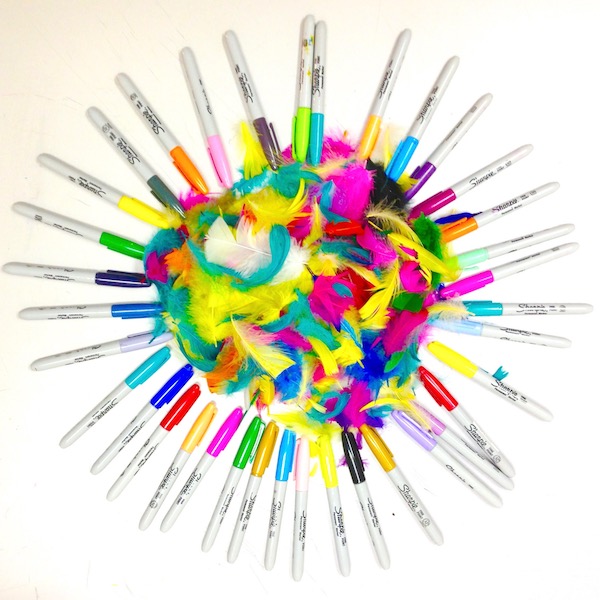
“Inner Circle”
By Helen Ellis, ATR-BC, LCAT
A mandala is a circle, a symbol of the universe that is used as an aid to meditation. Some art therapists make mandala-making a primary part of their therapy practice. Although this is not true of me, I see a mandala as a representation of wholeness, and experience has shown me that creating mandalas can be very therapeutic. In spiritual traditions, mandalas may be used for focusing attention and establishing a sacred space.
READ MORE
In therapy, creating a safe space is paramount, and focus and self-reflection are ongoing goals. With children that are very disorganized, that lack focus, that have difficulty containing themselves, a paper with a pre-drawn circle to work within can be very helpful. It creates a frame, a container, and the circle form surely contributes to a feeling of centeredness. According to Carl Jung, who wrote extensively about mandala symbolism, “The severe pattern imposed by a circular image of this kind compensates the disorder and confusion of the psychic state—namely, through the construction of a central point to which everything is related.”
An eight year-old girl came to see me for weekly art therapy. She landed in foster care because her father disciplined her and her siblings with regular, severe corporal punishment. She struggled with severe anxiety, among other things, and each week when I greeted her, her brow was furrowed with worry. But she loved making art, and found some safety in the sessions. She was easily engaged and lively, and enjoyed the looseness and playfulness of the art process.
But experience had taught her to contain herself and to avoid messing up at all costs. So when she did allow herself to loosen up, she could only enjoy it for a little while before the anxiety came flooding back.
In a memorable session, we spent time blowing colored feathers into the air (her idea) with a hair dryer (my idea). After we had spent some time on this playful, silly, fun activity, I became aware that she was becoming anxious. This surfaced in the form of a kind of forced jocularity, a change from fun silly to nervous, fake silly. And I knew that giving her a way to contain her anxiety (Jung’s “disorder and confusion of the psychic state”) was very important. So we brought things down to earth and made this mandala (Jung’s “construction of a central point to which everything is related”).
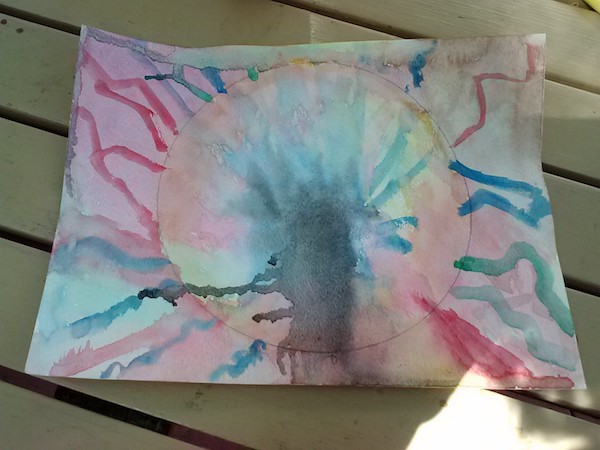
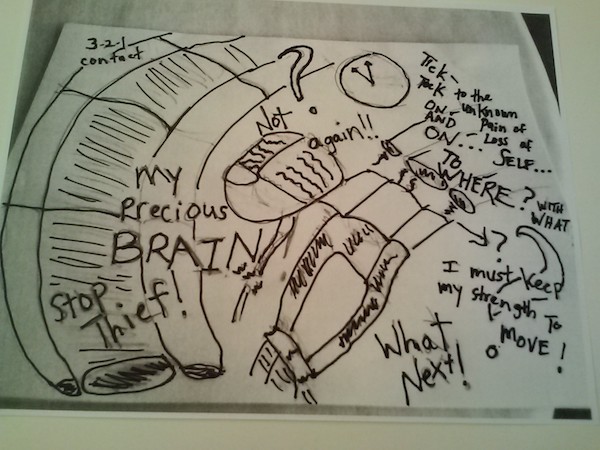
“The Power of Art Therapy”
By Christina Hom, ATR, CRC, LPCC
The power of art therapy truly has healing benefits. During my art therapy internship, I worked with Sue, a woman residing at an assisted living community. She lives with anxiety, multiple sclerosis and diabetes. Sue explained to me that her diabetes did not really bother her and that she had learned how to deal with this medical condition. The impact of having multiple sclerosis, however, really did concern her, especially the progression of the illness. Our art therapy sessions focused on this and ways to deal with her anxiety. She created a watercolor mandala and a multiple sclerosis drawing. Art therapy helped Sue improve her quality of life by being able to express her feelings, insights, fears and learning ways to cope in her daily living. She was able to find contentment, acceptance, and meaning in her journey of life.
“Breaking Through”
By Diane E. Roberts, MAAT
I was working with a Girl Scout troop while giving a presentation about art therapy. One Scout, with a history of severe social anxiety, sensory issues, and crippling shyness, was working very intently on her art piece but appeared to be having an intense emotional reaction to the noise and movement of the other Scouts. I have known this girl for about five years and only rarely has she engaged with most of the girls or adults other than the main troop leader.
READ MORE
In an effort to help her regain some focus, I sat beside her and began asking questions about her art piece. She worked for a brief time without speaking to me, and I was certain I was simply going to sit with her while she worked.
Unexpectedly, she began speaking to me, without looking up from her work, about her drawing and what she wanted the elements in the piece to represent. Before I knew quite what was happening, she began expounding on her feelings, how making something was helping her cope with the sensory over-stimulation, and how she really liked expressing herself without really having to talk. This was a huge thing! For the first time in five years, I saw her engaging with someone in a dialogue that was not arguing with her family or a desperate attempt to awkwardly socialize with a peer.
That was one of the first moments that I fully understood the power of art therapy and why there was nothing else I’d rather do with my life and talents.
As I was still a student, I gave her and her mother contact information for a local ATR. Last I heard, she was seeing both her traditional and art therapists regularly and had shown significant improvement with her social anxiety.
“Is this what you do all day?”
By Beth Gonzalez-Dolginko, ATR-BC, LCAT, NYS-LP
I have been an art therapist since 1974. I’ve been asked by many, including my first internship supervisor who was an arts and crafts instructor, about what art therapy is. I’ve heard everything from , “Oh, you’re like an art teacher” to “So, do you repair art?”
READ MORE
But, a story that I’ve told many generations of students describes art therapy the best. When my son was about eight years old, he had to come to work with me briefly because I had to hear report before dropping him at a camp near the hospital, where I worked on an adult in-patient psychiatric unit. My son was fascinated by my well-appointed art room and helped himself to supplies so that he could make art while he waited. One of the Nursing Assistants came in while he was doing so and dumped a big pile of fruity tootsie rolls on the table in front of him–there was always candy on the unit for the patients because psych meds make their mouths very dry. My son looked up at me, and, with absolute amazement, he asked, “Mom, is this what you do all day? You make art with people and eat candy?” I could only answer him affirmatively. He told me that I had the best job in the world, and I agreed. What could be better than using art to help people and enjoying candy together, as well?
“Pioneering times three”
By Isolde G. Martin, ATR-Retired
When I finished my Masters in psychology / art therapy I knew that the latter was a newcomer on the psycho therapeutic horizon. Not to worry, I thought, as I am going to explain and strive for recognition. And I did! Repeatedly! While I lived in Istanbul, Turkey, I was invited to conduct a seminar about art therapy and its use. “What therapy?” A standard question I had already lots of experience with. “We use art as a therapeutic tool,” I usually started off.
READ MORE
And we went from there. “You mean painting pictures like a kid?” “Well, perhaps, or as an adult if you like,” I hoped that would reduce anxiety. More and more students came to the university to hear what I had to say. They were sitting down the hallway when the class room was full. I had an enthusiastic audience and an equally eager me. A huge bouquet of flowers was a reward much liked.
A few years down the road I started work in a clinic in Cairo, Egypt. “What therapy is that?” some asked suspiciously. “You mean painting a picture instead of talking?” I often had the feeling this was an issue of dignity to them, i.e. not to reduce yourself to child level. “Can you take those art materials away,” one lady asked me. “No, put them where I can’t see them,” she demanded. But they came to group therapy to paint pictures. Painting was nobody’s fault but the therapist’s. Thus, we do liberally. It was so nice to see the liberating effect it had on most to spill “it” out on paper and not having to take responsibility for action or content. This is weird,” one man said. I think they became believers despite themselves. And on I went from Egypt to the United Arab Emirates. I shall not forget the lady’s response to my art materials in full display on my table. “Oh, you are an art therapist as well,” she stated. “I know that,” she said surprising me. “I have done it in Egypt.” Really, great. No pioneering work required from me? However, about a year down the road I received an invitation from an American psychologist working in the psychologist department of a huge hospital in Abu Dhabi. Objective: Explain art therapy, it’s theory, it’s use, and how to conduct an art therapy session. I agreed to pioneer again.
“Art Therapy and Lasting Impressions”
By Angel Duncan, ATR, MA-MFT
An elderly man in his 70’s has limited use of his arm that will droop down while sitting in an art therapy session. He hasn’t done a lot of art in his life, thinking he couldn’t do it, and now in his 70’s he finds joy and ownership in his creations. It is difficult for him to manipulate mediums like oil pastels, colored pencils or markers as his hands will curl in, but paint is provided with paintbrushes that offer a grip handle that is easier to use.
READ MORE
On one particular session everyone was using colored pencils and markers and he grabbed a colored pencil and began to carefully draw tiny leaves and fill each one in with color. He complained how much his hand hurt and he was offered paints that he declined. He wanted to do this on his own terms. Upon the hour he laughed brilliantly and said, “My hand hurts like hell, but I did it!”
In art therapy the process of how art is created is observed; it is not simply about what art mediums are used or what the quality of the art outcome is; art therapy is a combination of all of these things that support participants in their personal journey, under the guidance of a registered Art Therapist. As this man massaged his hand, smiling and laughing at his creative accomplishment, another participant asked him what happened to his hand, wondering if he had a stroke. He said he was badly beaten as a child by his schoolteacher and that was accepted back then. He shared the physical beatings he endured throughout his child and adolescent years and as a result it gave him nerve damage. The hateful words that people spewed at him equaled the physical pain. His anger, resentment, shame and depression reflected in his failed relationships later on in life. Over the years he struggled to get through the pain, but he was able to find supportive mentors that cared. He credits those who encouraged him and he credits his attitude and art therapy sessions for the positive changes he’s been able to discover and self-express.
“The Little Tree”
By Kurt Fondriest, ATR, MFA, REAT
In a forest of magic and wisdom and of rainbows and fairies, lived a little tree who was smaller, by far, than any other. He knew that his branches were supposed to be strong and always reaching upwards because his mother and father would tell him so.” Little tree,” they would say,” stretch your branches up to the sun so the birds may come play music on your limbs.” With all his might, he would try to reach for the sky but he could not hold his branches high for very long.
READ MORE
Little tree would lean sadly against his mother while he watched all the branches of the other trees in which birds of all colors and sizes were nesting and singing praises to the magic of the forest. His own little branches could barely hold his leaves, and they ached with pain. Across the valley of blue and sunlit flowers lived a wise old forest elf. Little tree’s mother called upon him to see why her son was having such a hard time with his childhood roots. It was a cloudy day in the forest when he came to see little tree and the silver reflection on the leaves from the recent rain mirrored his image and his magical bag of potions. The elf was the wisest soul in the forest; Surely he could heal little tree. Wise old elf embraced little tree. ”Ouch,” cried little tree. Father tree started to scold his son.” Quit being such a little sapling. Let the old one touch you, he will heal you.” little tree started to cry. Wise old elf said “why do you start a rainstorm on me, little tree?” Little tree turned his leaves so he could better see the magic one. “I hurt from my roots to tip of my crown,” he said. “My branches feel all twisted and knotted. My trunk feels as if 1000 woodpeckers were doing their noise making dance on me”. As his tears continue to fall, he said,” I feel more like a weeping willow than a royal oak. My branches cannot hold the beautiful song makers of the Valley nor the colorful rainbow of butterflies that take flight.” With this, little tree dropped his branches to where they took the shape of heavy, wet rope. Wise old elf stepped back from under little tree. He stood there with all his magical devices, rubbing his fingers through his snowy white beard. The clouds were parting and the sunlight started to dance down from the sky, warming the Valley. The blessings of the wood fairies could be heard as they gathered on the shoulder of the wise elf. One magically whispered in wise old elf’s ear.” What is wrong with little tree? Hurry and fix him so we may color his leaves with earth tones for the coming fall.” Wise old elf held his powerful arms up to the heaven and asked the creator of the forest for guidance. You see, wise old elf had magic that could do many things of wonder, but he could not heal little tree. To him, this young tree looked just like any other small tree in the forest. He came from strong roots, and from a family of shading grace. Wise old elf had seen the entire forest grow from the beginning of time. He remembered the first rain onto this once barren field, which was now linked together by intertwining branches of love.
Little tree leaned his heavy burden branches around his mother’s.” I’m so scared because of how I feel. It hurts, mommy, and no birds will sing their songs in my branches because I cannot hold my arms to the sky. Why do I have this pain and hurt? It is not fair that no other tree my age feels this way. All I hear is the echo of tree teasing from others. Sometimes I wish a lumberjack would come along and…” Just then, a radiant light danced down from a mighty Golden spiral in the sky, lighting up the face of wise old elf. A low, humming noise was whistling through the Valley until it came upon the ear of the old elf. “Little tree,” spoke wise old elf. Little tree turned his leaves once again so he could see the old elf. All was silent in the Valley. Even the wind had become voiceless. The birds of the forest bowed their heads in silence. The animals crept up to little tree, filled with love for their brave, little branched friend. The fairies surrounding little tree, holding golden balls of light that were reflections of the sun’s warmth. Wise old elf walked under little tree and raised his head, looking upward into his branches. He lifted his hand to touch one of the small, drooping branches.” Do you know why you feel pain in all your branches?” “No,” whispered little tree, as his leaves were gently stroked by his mother’s branches. The wise elf summoned for all the forest to listen by singing an ancient forest song. Golden light in the air I breathe touching all my branches from you to me we all are branches of the one loving tree bless the forest with understanding the pain of our little tree. “Little tree,” spoke wise old elf, the name of your pain is fibromyalgia.” The word was winded throughout the entire forest.
“Fibromyalgia is a painful bark condition. It can make your roots so painful that you’ll want to cry, and it is okay to cry. You must understand that maybe your branches cannot hold the birds to make the music, but they can hold the caterpillars until they are born into butterflies. Maybe you will not able to reach all your branches to the sky to touch the sun, but the Earth needs shade at times and lower branches like yours are the perfect ones. Yes, you will feel pain for no forest is perfect. However, you must remember you are a royal oak and you will always be a tree of strength and truth.”
With this, the entire forest of trees interlocked branches to form one. The old elf lowered his head turned to walk towards the hills of home. A swarm of lighted fairies lit his path as the sun was lowering its face into the sky. Fall came to the forest and then winter. Months passed while wise old elf spent his days doing deeds of good throughout the forest. It was on the first day of May when a purple passion flower fairy landed on the old elf shoulder.” ah,” said Wise old elf,” you bring me news of my friend, little tree.” The old elf snuggled the fairy in his vest pocket and spoke that he must journey to see for himself.
The fields were of mustard yellow and the scent of dandelion blanketed the spring top crescents. The winding road seemed steep for our elderly friend. As he came to the clearing, clouds of rolling, white peaks cast shadows to the earth below. At the top of the hill stood little tree, who was not so little as before. The old wood elf stepped up the hill to the trunk of his little friend. What he saw was not the same as nearly a year ago. Little tree turned his leaves so he could greet his longtime friend. ”Little tree,” exclaimed wise old elf,” Your branches are filled with light colored butterflies and your roots blossom the most beautiful flowers that grow in any forest shade.” Little tree spoke with a voice of confidence and quiet strength.” Old wise one, take heed of the forest vines that grow around me.” The old elf squinted through his glasses. He saw how the vines of the earth had grown up little trees limbs and wrapped and secured them with their support.” Wise old elf,” spoke little tree,” each day in our forest I awaken with pain. I still pray to the great creator of the forest to take away this spell in hopes that one day my bark will all be well. But I must tell you that there is no pity here, only courage. Courage comes from my friends of the forest who help me each day with the spell of fibromyalgia. When the rain comes down to fast and hurts my limbs, the older towering trees will bend their branches over me to keep me dry. The sun dances warmth onto my crown which helps the pain every morning, especially after the rain.
Wise old elf spoke while touching one of little trees branches. “In our forest, we will someday break this spell. Until then, little tree, you will overshadow us all with your courage and the strength of the beauty you tell.” And with this, the old Woods elf embraced little tree while dancing fairies sang songs of the wood bees.
The end
“Therapeutic process through art, self-reflection and visual processing”
By Michelle Belanger, MPS, LCAT-LP
Art therapy to me is a self-soothing process and coping mechanism that guides in the facilitation of self-care, mindfulness and healing. Art can make a person feel uninhibited and transparent while tapping into emotions. The therapeutic process of art making allows the use of all of ones senses and dives deep into the levels of the unconscious.
READ MORE
I use art to emotionally survive, thrive and navigate my therapeutic process. I use a similar process with my clients as well. I feel if I did not have art, I would have an increasingly difficult time coping, understanding and working as an art therapist. The expressive modalities have given me purpose and a voice when I am in need; whether the need is something grand or simply an emotional release.
As a survivor of trauma, I feel that it would be a disservice to others and myself to not share my art therapy experiences as both the patient and the clinician. At an early age, I discovered that art was not only about the tangible piece that you developed but the process behind your creation was just as important. My knowledge within the arts and experiences has helped me immensely working in the mental health field. I have worked primarily with children and adolescents who have traumatic backgrounds, as well as those with emotional and behavioral difficulties. Being able to work with, share and collaborate with my clients, gives me hope everyday.
I currently am in a long term therapeutic relationship with a client and have seen his art transition throughout our time together. He began treatment seemingly quiet, withdrawn and worked strictly with pencil and white paper. He has evolved in his choice of art materials, he displays a wider range of affect, self-awareness and verbal communication. He creates three-dimensional pieces, abstract representations of himself and uses various modes of expression such as music and movement in our sessions. I feel these changes have occurred due to rapport, my established therapeutic holding environment and the client’s desire for growth and change. I feel that art is a catalyst and necessary guide in my client’s progress and overall well-being in his therapeutic process. Art and art therapy practices work as a metaphoric expression of emotion. Art acts as a trigger yet a safety net for for one’s experiences and growth.
“The Case of Abby”
By Mari Grande, ATR-BC, LCAT, LCSW, MFA, NCPsyA, EMDR
Abby is fragile, we cannot go very fast. She will “leave the room.” She tells me when she does this. I have to move slowly. She wants crayons; her voice changes, she becomes very young. I go along with her. I meet her; I sit with her on the floor, where she feels most at ease, even though she is 68 years old. She wants to tell me about her dreams.
READ MORE
She had two, we decide to use art because she goes into her head, her thoughts swarm like flies and can take her places she can’t bare. She “knows” too much, she repeats too much. When she starts to draw her dreams she remembers more of them. She cannot make the image, just colors and lines, it is enough for her, and it is plenty for me. She wants to be near, she wants her mommy, she will never have her and she is angry. Art therapy for Abby is a way to connect, to me, to parts of her and to begin to develop trust not only with another person but also in a process, the creative process so vital to the philosophy of art therapy.
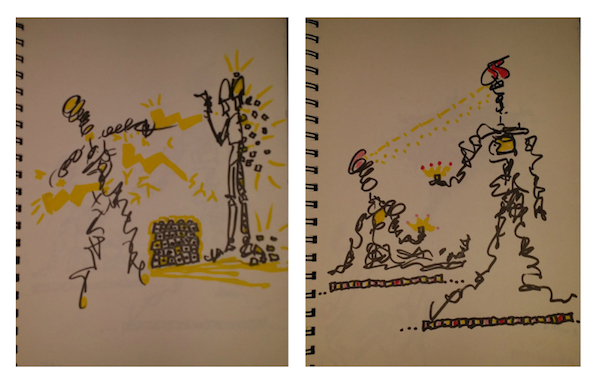
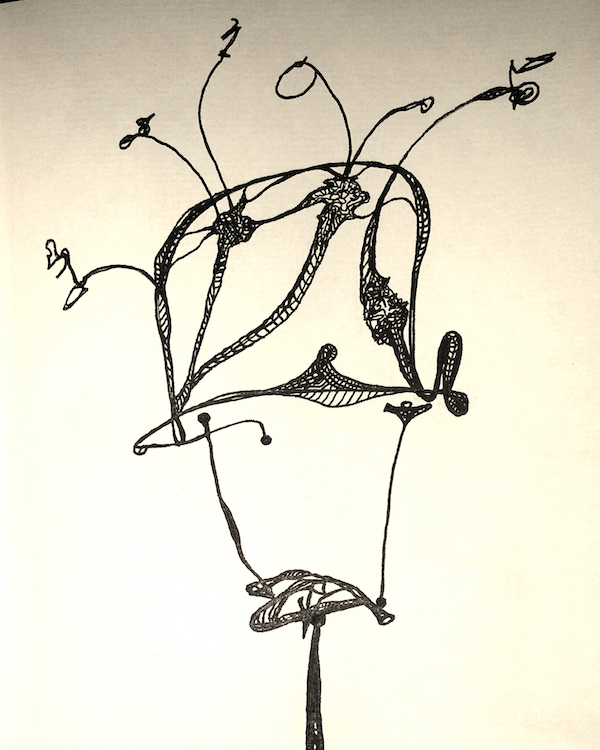
“Flipping the Script! Transforming the Inner Critic”
By Jenna Broderick, BA, MS (May 2018)
One of my most priceless ‘Ah-ha!’ moments came to me by way of a homework assignment my first year of grad school. The class was Psychology of Art Materials and our assignment was to do something nice for ourselves every day for one week then share it with the class. I chose to be more mindful and diligent about flipping my ever chattering negative self-talk to something more positive and encouraging. That is when I found the Inner Critic directive in Focus- Orienting Art Therapy by Dr. Laury Rappaport.
-my mind goes, 2015
This experiential involves creating two images and a mediation between the an inner Critic and Criticize by way of an actual dialogue: 1- the felt sense of the current relationship between the Critic and Criticized 2- and the felt sense of how you would like the relationship to be
READ MORE
Helpful questions for the Critic include, “What is your intention in being so critical? What are you afraid of? What do you want for me?” Helpful questions for the Criticized are, “What does it feel like to be criticized? What do you want to say? What do you need?” (Rappaport, 2009).
My Critic often scolds me for taking on more than I can actually accomplish.
My inner critic is a bully and quick to project a doomed future for myself. In the left image above you see the Critic taking all of our energy and chastising me with threats of falling apart mentally and emotionally. The work begins as my Criticized-self inquires why my critic-self has to be so harsh. To that the Critic explains that it was worried I would not heed the warning. The Criticized acknowledge the Critic’s fears and asked that she try to rework her manner of warning. Instead of attacks, the Criticized asked to share the mental energy and soften the warnings. In the end, we find ourself working toward a more balanced relationship that honors me as a whole.
I am so grateful to have taken Psychology of Art Materials my first semester. The transition into graduate school was not easy. At times the emotional toll seemed as if it would consume me. However, it was our class’ exploration of art materials and techniques, such as the one above, that aided me in maintaining a healthier mental wellbeing.
“How Creative Journaling saved my life: Discovering Art Therapy by Accident”
By Lupia Capacchione, PhD, ATR, REAT
I had 2 successful careers (one in art/design as creator of mass produced inspirational posters in the 60 and 70s, and a second in Montessori education and child development as a Head Start supervisor and college instructor), I fell ill. I spent the summer of 1973 in bed, exhausted, in pain and unable to function. Adjusting to life as a single parent after my divorce in 1971, I was dealing with accumulated stress from 5 years of chaos, moves, emotional turmoil, work stress and adjusting to life as a single parent of 2 young children.
READ MORE
While bedridden and wearing for my life (doctors could not adequately diagnose or treat my condition), all I had energy for was drawing and writing. Without planning it, my sketchbooks morphed into art journals full of a style of art I did not recognize as my own. These “strange” drawings form the inside out were “written in another tongue”. Slowly I began to feel better. After 3 months of therapy (gestalt, Transactional analysis, neo-Reighcian energy work) and a total of several months of journaling, I recovered completely. A friend told me I was doing art therapy in my journal. I had no idea what she was talking about, so I researched the new field. Eventually I went into art therapy as a client for several months followed by entering an external degree Master’s Program through Goddard College in Plainfield. VT. I have been in private practice since 1976, have 3 best sellers under my belt, and just published my 19th and 20th books:
Drawing Your Stress Away and Hello, This is Your Body Talking (Draw-It-Yourself Coloring books using my Creative Journal approach in a coloring book format). Next year I will turn 80 and my Professional Training Program, Creative Journal Expressive Arts, will turn 20 with 82 active members using my methods all over the world schools, hospitals, counseling centers, with vets, in addictions treatment and cancer support groups. At 80, I feel that I am just getting started.
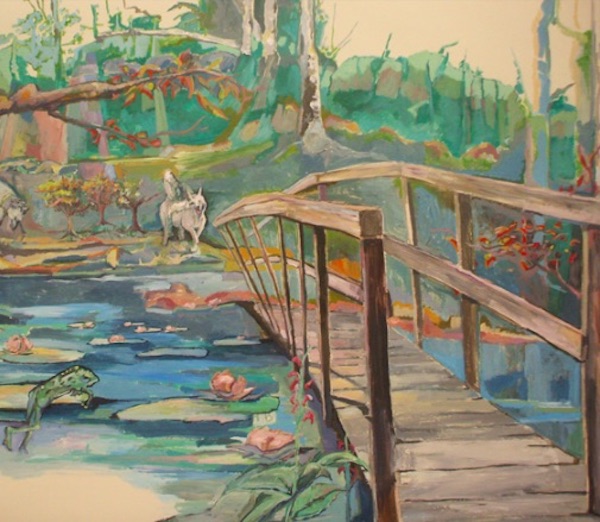
“Developing Visually Restorative Environment in A Locked Psychiatric Environment”
By David Ohm, ATR-BC, LPC
This is a personal journey about my use of paint in the hallway of a locked psychiatric unit. I was asked to paint a mural after a recent conversation with a group of patients. What do I say as a painter and “Art Therapist”. The hallway looked closed in, I felt closed in, the patients and staff expressed a similar feeling. I was not being empathetic since I did not need to try too feel like what the patients were expressing.
READ MORE
The walls were tan and few windows to the outside world on that unit. The walls had plaster patches from years of holes being patched. It was like a map of past violence just below the paint surface. I said yes and collaborated with all involved to paint an “Open Space Theme”.
The first thing a patient or staff views when entering a psychiatric facility affects how they feel about being in the environment. This feeling could be hopeful, fearful or anything in-between. Honestly it was far from hopeful. I believe that restorative imagery in collaborative mural painting has a practical advantage over other forms of creating recovery based environment. This practical advantage is the fact that mural paint physically becomes part of the wall and is unable to be used to harm self or others. The question is how can I be a part of this wall transformation?
I will let the mural tell the story: We are at a bridge and do we try to cross it or stay where we are? No one else crossed it yet so why should We. Others were asked to create but just walked past the bridge. I wonder if they were afraid to drown in the water. Only one way to find out just test the bridge and see. At least there is a place to go. An open space, with animals, water trees, plants and sky. All the things you need to live.
I know it is just paint but we have something to give. The next mural we paint together and you call be Bob Ross. Sorry I can not show that one, you know confidentiality. You painted your own animals, trees plants and sky. I hope the inspire others to create change, and not just walk by. We create space and space can shape us. Art Therapists not be afraid to DARE;develop aesthetically restorative environment.


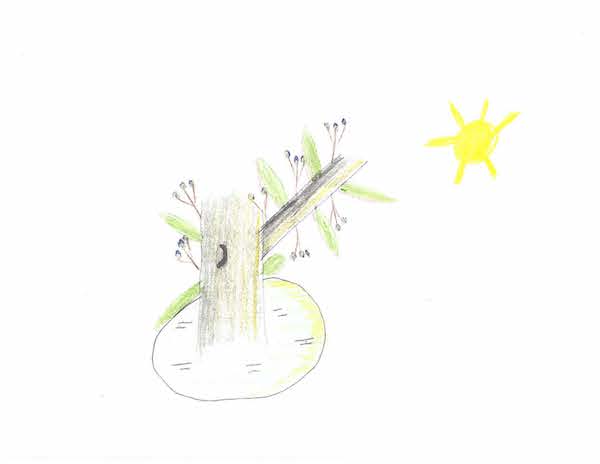

“Person-centered Art Therapy Makes Explosive Gains”
By Erich D. Montfort, MS
During my Nazareth College internship, I was sent to a maximum-security forensic psychiatric center, voluntarily of course!
Despite pressure to apply DBT, CBT, and all those other intimidating acronyms on these patients, involved in the judicial system due to mental illness, I offered person-centered art therapy. Forty-five minutes a week, I provided each patient unconditional positive regard, and this turned out unexpectedly healing for those who had experienced so much negative attention in the events leading to their incarceration.
This was especially true for Curly, a short, stocky, tattooed, and bald man, whose name has been changed in this story for confidentiality. Curly was my first client, and much to my dismay, was admitted for problems with Intermittent Explosive Disorder. Handing a sharpened pencil to this patient, I thought that I might as well hand over a loaded gun.
Meticulously, Curly drew small shapes. He drew a line, erased it, and redrew the line again. He wanted perfection, and I could almost hear the sizzling fuse between his ears threatening to blow. “I like those interesting imperfections you make,” I said, intentionally adding flaws to the tree I happened to be drawing. He watched as I integrated the inconsistencies into a unified and more interesting whole.
He suddenly ditched his discomforted shapes, to draw his own tree, and I sat surprised, witnessing such a tough-looking man draw such a sad-looking tree. With severed club-like branches, spear-like twigs, and a prominent gaping hole, I thought it could be isolated enough to excite even the renowned Emanuel F. Hammer, himself! I knew we were finally getting somewhere. He asked if I could teach him how to shade next session. I agreed.
But, next session I hid his preferred-pencils to teach the wonders of watercolor! Much as watercolor is a prone to unexpected mistakes, I was an art therapy intern prone to punishment. However, having the courage to become vulnerable, with Curly, turned out to be worth the risk.
In the following months, he painted a series of watercolor trees, and together we discussed and processed his hopes and dreams, his triggers and stressors, his fears, and even his deepest regret. On the day he relapsed, I was still there, unconditionally. Like all of us, he was much more than the worst things he’s done. In his final painting, not only was the hole in his tree finally healed, but also it was blooming.
“Art as Another Language”
By Anne M. Warren, DAT, ATR-BC, ATRL, LPC
The other day I saw this photo of a summary of how the presentation of a play full of dragons and magical scenes went on a day when there were classrooms full of students in the audience.
This made me think about a little boy an art therapist saw a while back, who refused to speak in public. He was about 5 years old, and in kindergarten at the local public elementary school. He occasionally whispered to a classmate, but stopped when noticed by his teacher. He never spoke to the teacher, or any other adult while at school. He would talk in a whisper at home, but not often.
READ MORE
His foster mother came in alone and explained that he had experienced trauma in his family of origin, and she had stepped in to care for him, hoping to adopt him. She hoped that art therapy might help, given his love of creating art, and, of course, his refusal to talk. She seemed tense, and talked about how stressful this was in their family. She noted that there seemed to be no laughter at home. She couldn’t remember the last time she had laughed.
The art therapist had not treated selective mutism before, and gave a lot of thought to how he might work through his difficulty communicating. As an art therapist, I know that art is a form of communication, and that it can evoke emotions in people. We all know that from our enjoyment of art, or how art can stir controversy. But how was this art therapist going to use one form of communication to spur another?
The art therapist decided to tell him right away that she knew that he didn’t like talking, so in her office, talking was not required. In fact, he would not talk, but instead draw what he wanted her to know. They began their art-making session with one question: “What would you like to do first”?
I understand that his eyes lit up, and he glanced at the display of acrylic paints on the table behind the art therapist. He drew a picture of a paint bottle using the paper and markers on the table in front of him. Mother watched nervously as the art therapist talked and he drew through the first ten minutes of the session. He made scribbles in the color of paint he wanted and watched as it was poured out onto the pallet. The art therapist chose some brushes for him, and put out water and towels, chatting all the while.
He sat on Mother’s lap and readied himself to paint. As soon as the paint touched the paper, he began to talk. He told the therapist all about his morning in kindergarten, his dog at home, how much he likes swimming in the summer, and how he loves his dog. A 30 minute session drew out to 55 minutes while he painted and talked, and the therapist listened and renewed paper, paint, and water. At the therapist’s urging, he painted things he loved, and things that scared him. He painted his new family, but not his old one. He painted a dark cloud that he said was “bad things” and he painted a rainbow when asked how he felt right then. He was not pushed to remember his trauma, or explore it. After all, it was a first session, and they were just getting to know each other. They completed their session by walking down the hallway towards the reception area chatting all the way, Mother trailing behind. He was given a sketchbook to take with him while Mother made more appointments.
What happened in that art therapy office that day? Was it the permission to not talk that triggered his speech? Or perhaps it was the fun game of drawing his wishes. Was it the painting itself, or his knowing that he was there because he wouldn’t speak and the art therapist was the person who allowed him to talk in images instead? It could have been all of the above, but I think that moving the paint across the paper was important to the release of words for that little boy. He never returned to see the art therapist. Mother called and cancelled all future appointments because he continued to talk-to everyone, everywhere. We never did get the chance to explore his trauma history through art, but perhaps the dark cloud image was enough for now. When Mother called the art therapist to cancel his future appointments, she talked about how things at home had changed. She said that the tension at home seemed lessened and everyone seemed happier. Foster Mother asked if there might be a way to get him to stop talking so much should they get tired of his happy chatter in the future. The art therapist told her that they’d cross that bridge when they came to it, if ever. She laughed.

“Inside/Outside”
By Tracy Councill, ATR-BC, LCPAT
A young woman who had been fighting a rare solid tumor diagnosis experienced an intense onset of symptoms that left her with big holes in her memory. When she got out of the hospital, she used art therapy as an outpatient to both process her feelings and retrain her memory.
READ MORE
One day in particular she reflected on times when she felt she had to show the world a different state than what she was actually feeling inside. Friends might ask, “you look great–are you better?,” but an authentic response was complicated.
In art therapy she created this watercolor to explore her conflicting “inside” and “outside” states and see what clarification might come from putting it in image form.
For two hours she painted and talked with her art therapist about how she “really” felt versus how people thought she “should” feel.
When the painting was finished, she explained that the process had helped her understand that what she needed most from people was time. She closed the session by saying, “Thank you for being here. Where else do you get to really talk about what’s happening and then spend a whole morning making it into a painting that totally means what you were trying to say?”
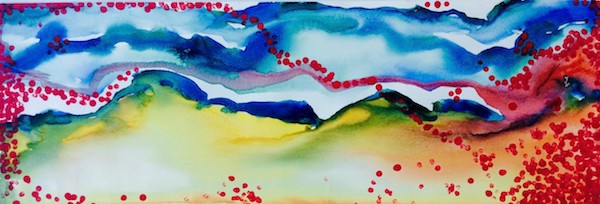
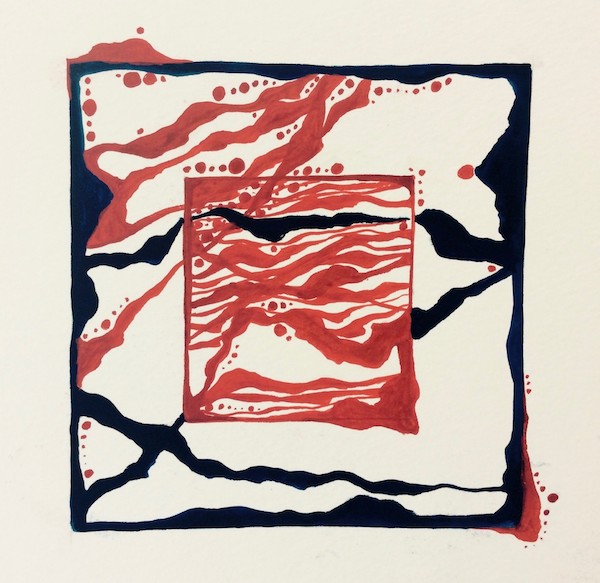


“Red Dot Messages”
By Sally Rudolph, MA
At the Art Therapy Conference in Seattle in 2013, I found myself alone in a space that had art supplies on various tables. I happily made a colorful abstract landscape, enjoying the quiet activity in the middle of a busy weekend. After I created my landscape, I took a dowel and some red paint and made a path of red dots along the “mountains” and into the sky. And then I moved on to more presentations.
At the time the painting did not mean very much to me, but it seemed to have kick-started a new phase in my art. For the next 10 months I painted several more small and simple red dot paintings when I could sneak in the time. So many red splotches in various compositions emerged. They marched along the pages as if they had a message to deliver.
It was not until I found myself in the hospital undergoing tests, enduring procedures, getting blood transfusions and painfully facing a life-threatening blood disease that I understood what I had been painting. For 10 months my body had been trying desperately to communicate with my brain. It had been
calling out to my conscious, expressed through my paintings, that it needed help.
I was painting my blood.
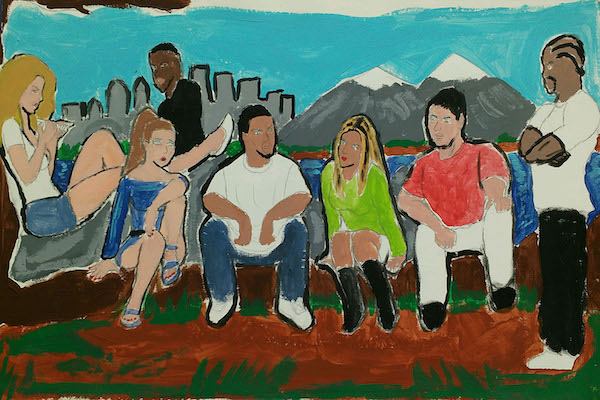
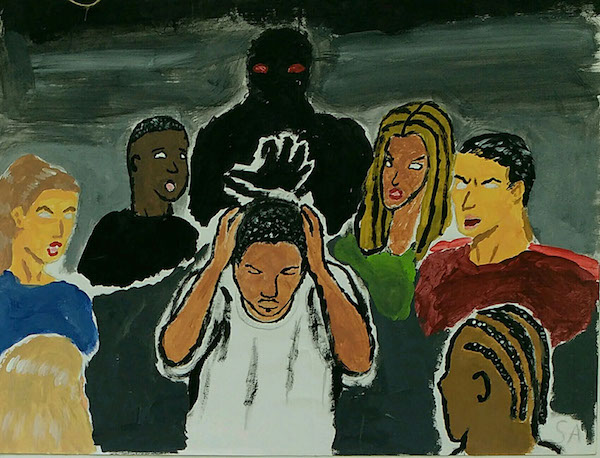

“Hearing the Unknown, Taking Charge, and Communication”
By Kirsten Knoblauch, MA
Stefan came to therapy struggling with depressed, unstable mood. In our early work together he disclosed a history of trauma, that he hears voices, and that he had not talked much about either of these experiences. He started hearing voices when he was young: “It started as a whisper, then multiple whispers, then turned into multiple people trapped within the box of my mind …Sometimes I would try to think or imagine something good, and they would turn it into something cruel or disgusting. I was freaked out.”
We began exploring connections between his past experiences and current struggles, including the seeming emotions and motivations of his voices. Through the course of therapy Stefan came to identify that his voices represented various parts of himself, and that these parts may in fact be terrified and hurting – just like Stefan has been. He began using art making to explore with these “parts”, and between his parts. This included the series of images show here titled Hearing the Unknown, Taking Charge, and Communication. We explored these images together and he began to evolve his relationship with his voices:
“I learned that my voices are part of me, and it is OK to have a relationship and conversations with these parts of me. I learned if I don’t do that I will keep feeling like everything is against me. I realized that these parts of me are trying to guide me and that if I listen, they may actually learn to help me in a different way …They are not trying to make me do anything really, they are trying to protect me. …Now I listen to them more. I listen to whatever choices they suggest but I decide what to do. After a while they became not just voices but my friends. Now sometimes they whisper and tell me ‘you can do this, you can do something amazing.’…Day by day I try to rebuild my broken self. Years ago I lost my confidence. I am trying to regain that lost person, someone who isn’t afraid to speak his mind, to be more outgoing and confident, someone no longer afraid of his past, someone who faces pain head on and becomes stronger because of it.”
Stefan and Kirsten continue to work together. He has a number of goals including to create and publish a comic book someday, and to share his work with the public.
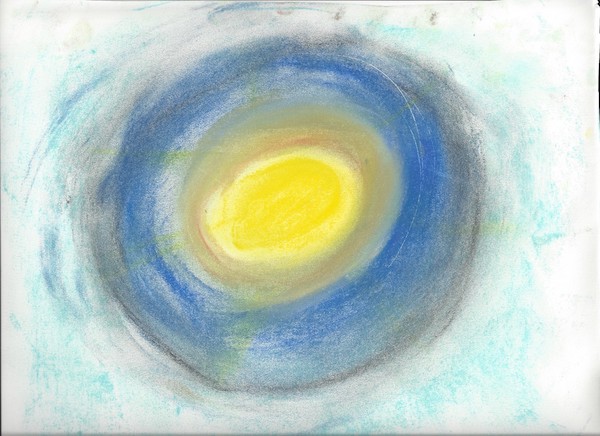

“James Looks and Listens to Our Art”
By Michael Pretzer, LGPAT
I was at the sink cleaning brushes when Helen, the clinic’s music therapist, burst in. She had found James sitting at a table in the lunchroom, staring into space. She wanted my help.
James had been enrolled in our clinic for a couple of months. He had taken to music therapy immediately, but only slowly did he warm to art therapy. On his own time he drew in a sketchbook using chalk pastels that belonged to his mother, yet he was reluctant to come into the studio. He dropped his resistance, however, after I suggested we draw together—he with his mother’s pastels and I with pastels I’d had since high school.
When Helen asked for my assistance I grabbed pastels and paper and joined her sitting with James at the table. We realized we needed to bring James back to the here and now, and we believed that art had the power to carry him home. Helen and I began to draw. Without an intention to collude, we both created abstract images in yellows and blues. Helen drew in a circular motion, and I made horizontal shapes. I whispered to James to look at the light (in our drawings) and listen to the sound (of the pastels scratching the paper). Helen and I moved our drawings directly in front of James so he could see and touch them. We put our hands on top of his and waited as he slowly returned from his other world.
